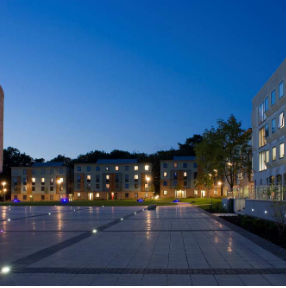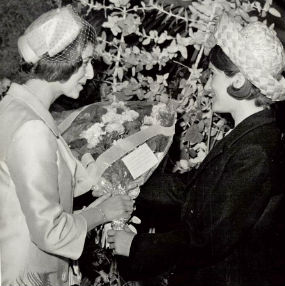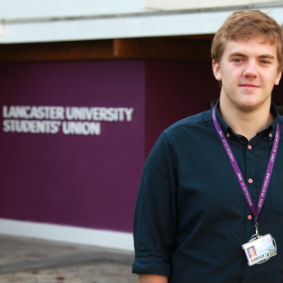Remember When
Here are some of the people and events that have made the University what it is today.
Send your memories and anecdotes (max 300 words plus a high resolution photograph) to alumni@lancaster.ac.uk.
We’ll include as many as we can.
The Establishment of County College
Celebrated as one of the most popular choices for incoming students, the largest college on campus and named after the Lancashire County Council, County College resides in the northernmost point of campus. County’s motto is ‘Nothing Without [The] Council and the college colours are blue and bright golden yellow. The County Council donated generous sums of money towards the construction of the college and promised to donate £50,000 a year for a decade towards the University’s running costs.
The original college building, County Main, was opened in 1969 by Queen Elizabeth II and centres around a large oak tree that is approximately 200 years old whose roots remained safe as the college buildings were erected. An oak leaf is the logo of County and it is also included on the college’s Coat of Arms which were officially granted by the College of Arms; the designer of the logo, architect Roger Booth, won an award for it. Unofficially, the motto of the college is ‘Do it for the tree’. In 1978, County West was constructed and in 2004 the college continued to expand into the old buildings that were vacated by Cartmel College. These buildings were refurbished and renamed and the college bar, The Northern Oak replaced the old Cartmel bar – it was reported in Steps, the Lancaster alumni magazine, in 2005 that when construction was complete, the college would have doubled in size. County West was demolished in 2007 to make space for the townhouses, which look out onto Lancaster Square and were opened in 2008.
The County College may not be the oldest college, but it continues to flourish. It was also host to a short visit by the Queen in October 1969, where she unveiled a commemorative plaque to honour the contribution of the council. The Northern Oak is host to live music nights called 'Live At The Oak' – which take place every other Wednesday during term time - and the County Comedy Club which is organised by students, encouraging more cultural aspects of collegiate life. Notable alumni include Andy Serkis, who played Gollum in the ‘Lord of the Rings’ films who graduated in 1985 after studying visual arts. During his time at Lancaster, Serkis was heavily involved with designing and producing plays at the Nuffield Theatre and went on to work for local Lancaster theatre, the Dukes Playhouse.
Carole Helps to 'Plant the Seeds'
Carole Gardiner (English & Philosophy, 1967, Bowland) was one of the original cohort of graduates and reflects on how their year group were involved with the fledgling years of Lancaster and remembers the freedom of studying away from home.
Where to start? That first, rather windswept, morning, photographers and journalists were waiting for us as we filed into the old Waring and Gillow furniture warehouse, which would function as the main University building until the new one was completed. No-one knew quite what to expect. We’d have lectures in Lancaster’s theatre and a deconsecrated church would be our Student’s Union. The most familiar building was the Shakespeare pub, which quickly became very well used.
The freedom was dizzying ---- not just the usual feeling of being away from home and parental control, but the freedom to form a team, set up a society, found a newspaper. Everywhere, huddles of like-minded people in grey gowns were realising it was simply all up to them.
During that year, college scarves were designed, an inauguration took place, a New Universities Festival was participated in, a Boat Race planned with York and Paul Bucci was apprehended by the local police up a flagpole! There was also a garden party at Bailrigg, to which our chancellor, Princess Alexandra, was invited. As the President of Bowland College, I was asked, not only to present her with some flowers, but to sit next to her while we had tea (see photo!) Panic set in immediately. A slice of that term’s grant had to go on a hat, then there was the question of what to talk about, followed by the more important issue of whether she would eat anything, as royal protocol forbade me to eat until she did. Fortunately for me, the conversation flowed and she accepted a sandwich!
At the start of the second year, we all got a shock - more students had arrived and we didn’t know them! Our close knit group had to open up, absorb and change. Also, after a year of heady, buzzing activity, we had to get down to some serious hard work. Degrees were not going to be earned just by being the leading light of the Drama Society.
Eventually, the day came when we moved out to Bailrigg, feeling a bit isolated at first, after the hum of the town. But it was good to have a study room, access to the showers and lectures in proper lecture theatres, where you weren’t tempted to fall asleep in velvet tip-up seats.
Without warning, it felt, three years disappeared and we became the first cohort of graduates. It was over.There would be no more doughnuts in the JCR, no more having to return York’s signboard after the Rugby team filched it, no more parties with the younger lecturers, no more raucous evenings in the Folk Club.
Lancaster is a very different place now, but it’s still an amazing feeling to know we were the people who helped to plant the seeds of what was to come.
In the Beginning......
As we approach the 50th anniversary of the University, Vic Seddon (Economics, 1967, Cartmel) reflects on his time at Lancaster in those fledgling years.
Those of us who arrived at Lancaster University late in September 1964 knew that we were embarking on a rare and special journey; almost an experiment, it felt like. We were an unusual bunch for those times.
What am I saying? In retrospect, we were weird. As I recall, the average age was higher than 18 years (I was 19); there was a high proportion of state school and FE college students, including me. Almost everyone was up for new societies and creating traditions and pushing back the boundaries of the mid-60s freedoms.
It’s worth remembering that only about 3% of our national age group attended university at that time and we numbered perhaps 320 in the total intake. More or less, everyone knew everyone else. Some weeks before the first day at University, we were invited in smallish groups to a venue in Meeting House Lane, near to the station, to hear Professor Stan Sturmey and someone else deliver an “inspirational speech” about university life and some admin matters. I remember it especially because it was the first time I drove my Dad’s car without his being there and I scraped it along the gatepost at the car park. But it is true: we did feel privileged to be attending any university and the spirit of Lancaster was attractive from the first contact.
The first two years in St Leonardsgate were formative. Postgrads had been there already for a year when we undergrads arrived. The Waring & Gillow building housed the library and study-carrels, cafeteria, some tutorial rooms, academic staff rooms and the admin suite. Further down the road was the Student Union; was it called Centenary House? Also in that row were the bookshop and the Shakespeare pub. The Grand Theatre on the opposite side was where most largish lectures seemed to be timed. I remember lectures on February mornings, before any heating had time to work taking notes with gloves, scarf and a duffle coat (remember them?)
There was some organisational weirdness at Lancaster as well. For example, we all wore grey gowns with red yoke at lectures in the first year or two and we wandered about the city dressed in our gowns, much to the amusement of locals. But other aspects of the eccentricity were attractive and helpful. If I walked past Stan Sturmey’s door and it was open late in the day, I could lean on the door frame and chat with him about recent lectures and relevant headlines from the newspapers. He was a world authority on transport economics, but more approachable than any teacher or lecturer I had known at school or college and he was not alone in this. The VC, Charles Carter, was just as approachable. I met him at various social events and we chatted like old friends, not at all as I expected and with no sign of the age or status-differences between us. The same was true of the University Secretary, Mr. A Stephen Jeffreys; there was no problem speaking with him professionally or socially, regardless of his exalted status.
That atmosphere was inspirational, just as much as any tuition. There was real camaraderie, in the true sense of the word. I’ve worked in six other universities over the years, but early Lancaster was unique in all these respects.
For our final year, we moved to Bailrigg. Some of the facilities were improved, but it was a building site. There was mud everywhere and we took lectures in wellington boots. The bus underpass filled up with rainwater regularly because the drains or the pumps didn’t work. One morning, a big glass window in the new library was broken by the force of the wind straight off Morecambe Bay. I had a battered old car which the wind and rain seemed to blow under the bonnet frequently in the winter, so I had to push it to the roundabout and bump-start down the hill to the A6. Which didn’t always work, of course.
Opening a new university in the mid-60s was certain to cause a stir. Almost everything about young adult behaviour and expectations was different. The music, the sexual mores, even the modes of dress. Just five years earlier, and all these would have been different. We had Radio Caroline for almost exactly the duration of my undergraduate life, pirate-broadcasting from the Irish Sea.
The previous generation, my parents certainly, thought all this was regrettable and reprehensible; so we (meaning I) learned to be secretive. Today, that seems to be the normal relationship between parents and their children at university but it was novel and naughty back then.
Aspects of everyday survival were interesting. None of the original cohort lived in student halls. We were in lodgings, shared rooms, holiday boarding houses and a few self-contained flats. The most popular lunch in the cafeteria was soup and fruit yoghurt with a bread roll. Fruit yoghurt was new on the market and was regarded as “real cool”; literally of course, since it was chilled!
Out in the city, there was a Chinese restaurant in Church Street where you could get the set lunch for 4s 6d (22½ pence now.) Up near the castle was the Portofino Italian restaurant for special occasions. An evening meal there with wine could cost all of £5 - more than a week’s rent.
Many, maybe most, students received a local authority support grant then, in addition to payment of our fees. My grant was typical at £300 a year, so I worked on Christmas postal deliveries and a variety of summer jobs to sustain a decent level of expenditure.
I remember with affection and admiration so many academics who all shared a humane, helpful and caring approach to our learning as well as their own scholarship:
Professors Stan Sturmey and Pat Rivett, Dr (later Professor) Ralph Henstock, Paul Herrington, David Pearce, Alan Airth, Tony Cramp, Marcus Merriman and Austin Woolrych, the first Professor of History. It was contact with his History Department that helped me reassess King John, Richard III and Oliver Cromwell as probably the good guys.
I’ve been grateful to Lancaster University all my career and adult life; for its unusual and sophisticated approach to learning, to research and to the important job of getting along with people. I’ve not come across another institution like it. It nurtured this bright, but blundering youth and helped me develop my own approach to scholarship, teaching and management; and that’s given me status as well as pleasure that has lasted a lifetime
Forming Lancaster University Students' Union
The representation of student interests has a long history at Lancaster beginning with the Student Representative Council(SRC). Established in 1967, three years after the University itself, the SRC was already actively participating in staff/student consultation as early as 1968, with an elected President expected to attend important University committees such as Senate and the Privy Council in order to fully represent the incoming students of Lancaster.
The establishment of the SRC was partly due to a statement made by the National Union of Students (NUS) in the mid-1960s which sang the praises of student representation in the governance of universities, claiming that a student representative would ensure ‘wider and fuller opportunities for all students in the future.’ In August 1975, the SRC was renamed Lancaster University Students’ Union.
The Students’ Union is currently run by over 150 student officers across the University and consists of:- Full Time Officers elected each year by the student body; JCR Officers elected to represent and manage their colleges; Cross Campus Officers elected to represent students on a range of university issues such as charity, welfare, democracy etc and a variety of officers who represent clubs and societies, notably the elected heads of the student media.
LUSU resided in Bowland Annexe for thirty years after moving its offices there in June 1973. It was only in 2013 that it was finally moved to a more central position across from University House. In its present day form, LUSU is a tremendous educational charity with an appointed Board of Trustrees who have a responsibility to ensure that LUSU makes sound financial decisions and continues to represent the interests of students.
LUSU manages its own accommodation service, available to both Lancaster and University of Cumbria students, an advice and support service, the Jobshop which is intended to help students look for part or full-time employment, various shops around campus and online, the Nightline service, the Purple card and the Sugarhouse. The Union also has a dedicated volunteering service, Involve, which offers a wide range of volunteering services in the community, schools and with environmental projects.
The Union has a strong environmental and ethical track record which has led to it being awarded the Gold Standard by the NUS in the Green Impact Awards – making LUSU one of five universities in the UK to receive this honour. It was also shortlisted in 2013 for the High Education Students’ Union of the Year award at the NUS Awards.
(photo of LUSU with Tom Fox by Mae Reddaway)




.jpg)
